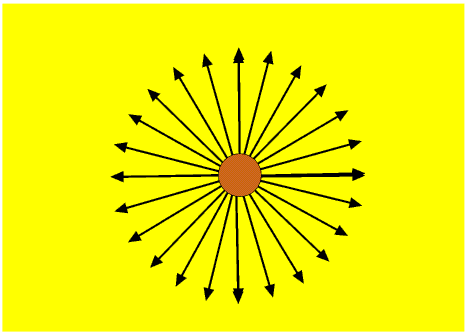
What we call white light is actually a mixture of light of all the colours of the rainbow. Each colour is light of a different wavelength, red light has a longer wavelength than blue. This is more fully discussed in the Pages of my Web Site on light and colour and on colour vision.
The Sun, or any other star, is giving out light in every direction.

The further we are from a star the smaller the angle between the rays.
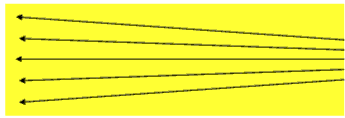
The sheer size of the solar system is hard for most people to understand, but you can get some idea of its size by going to the Size of the Solar System page of my web site.
The Sun is so far away from the Earth that by the time the rays of light from it reach the Earth they are almost parallel.
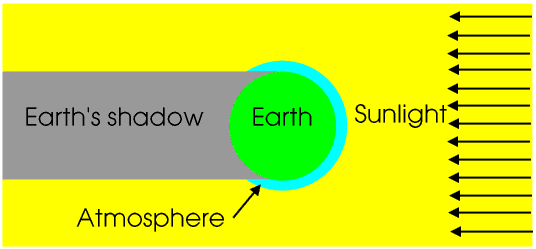
Of course you can only see rays which enter the eye so to someone at Point A the Sun will appear to be a small disc in the direction of Point B - a disc not a point because the Sun’s rays are not quite parallel; this is also why eclipses appear as they do. (The planets appear as discs when seen through even a small telescope, but you need a very powerful telescope indeed to see the stars as anything other than points of light.)

The Earth has an atmosphere. The atmosphere contains tiny droplets of water and crystals of ice, dust particles and pollens. These particles are far too small for us to see but they scatter the Sun’s rays. The scattering of light by particles in this way is called Rayleigh scattering, after the British scientist Lord Rayleigh (1842 - 1919). Even the atoms and molecules of the gases in the air are involved in Rayleigh scattering.
Usually all the light is scattered, although the amount by which the rays of light are scattered depends upon the size of the particles and the wavelength of the light, and a number of other factors. However the very tiniest particles, less than about 20 nanometers in diameter, scatter only the blue light. This is called the Tyndall effect, after the English scientist John Tyndall (1820 - 1893). This is why very fine smoke, particularly tobacco smoke, sometimes looks blue.
You can demonstrate this for yourself quite simply. The experiment is best done out of doors in good daylight. Take a very clean clear glass container such as a tumbler or jamjar, and nearly fill it with tap water. Now add one or two drops of milk (skimmed milk works best). If you look through the liquid you should see a blueness.
This picture shows what someone on the Equator at midday on the vernal equinox (March 21st) will see.

We can only see the part of the sky which is above the horizon. The Sun appears to be vertically overhead. The Sun is producing white light, that is, all the colours of the rainbow in certain proportions. The Earth’s atmosphere scatters this light. Usually most of the particles in the upper atmosphere are less than 20 nanometers in diameter and so only the blue light will be scattered. This means that the direct light from the Sun will contain a little less blue light and so the Sun will appear a little yellow. But the blue light is scattered again and again, and so eventually reaches our eyes from every direction. This makes the sky appear blue, and very bright: far too bright to see the stars. Although the direct light from the Sun is a little yellow, daylight is a combination of the yellow light from the Sun and the blue light from the sky and so appears white.
The drawing shows the atmosphere as a uniform layer with a definite edge, but of course it is not really like this: as we go higher the atmosphere gets thinner. At the cruising height of a jumbojet the atmosphere is so thin that almost no light is scattered: the sky is black and the stars are clearly visible even during the day.
This drawing greatly exaggerates the thickness of the atmosphere, but it still shows that all the Sun’s rays which strike the part of the atmosphere above the horizon do so vertically, or nearly so. So the sky appears a nearly uniform colour.Even a totally cloudless sky contains enough of these very tiny particles to scatter the light to make the sky blue. But clouds are made up of slightly larger droplets of water, so all the Sun’s light is scattered. This means that all the different colours reach our eyes from every direction, so thin clouds appear almost as bright as the sky, but white. This is why solar cells can produce almost as much electrical power when the Sun is not shining as when it is. However, water droplets also absorb light, so if there are too many of them, for example if the clouds are quite thick, the sky may be darker.
Seen from a point far above the North Pole the Earth is rotating on its axis anti-clockwise about once every twenty four hours. So after a few hours this is what we shall see.
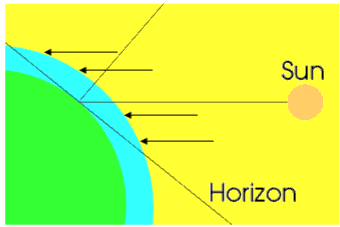
The Sun is much lower in the sky, and the rays of light from the Sun strike different parts of the atmosphere at different angles, and travel different distances through it. This means that although the sky is still blue and too bright to see the stars there may be small differences in the colour between different parts of the sky.
Because of the curvature of the Earth and the tilt of the Earth on its axis this is of course what most people see most of the time: only in the Tropics and even then on only one or two days a year will the Sun be directly overhead at noon. This is further discussed in the Page on the Seasons.
After a few more hours the Sun will be setting.
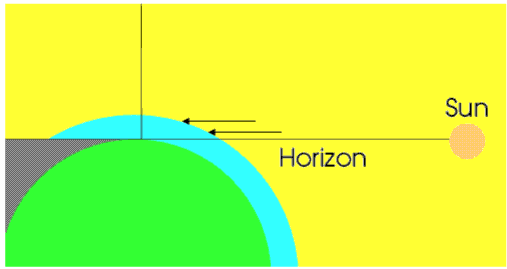
Now the Sun is on the horizon, and the Sun’s rays are striking the atmosphere at a very steep angle. The blue light will be scattered a lot so the Sun will appear red. It also appears much bigger than during the day, but this is actually an optical illusion.
The Sun sets in the West; because of the way we have drawn this picture West is on the right hand side of the picture and East on the left, although we usually draw maps with West on the left hand side and East on the right. The sky to the West is still very bright, but although the atmosphere to the East is not yet in the Earth’s shadow the light reaching it from the Sun will have passed a long way through the atmosphere and so much more of it will have been scattered or absorbed, and the sky will be much darker - but still too bright to see the stars.
Water vapour and dust in the atmosphere scatter the light in a really spectacular way when the Sun is very low in the sky, and this may produce wonderful sunsets. This is discussed later on this Page.
A few minutes after Sunset the Earth will have turned a little more.

The sky will still be bright to the West, where the Sun has set, but overhead and to the East it is getting dark and the first stars will be visible.
Finally we have nightfall, when the sky is completely dark and the stars are clearly visible, or would be if it were not for all the streetlights etc....
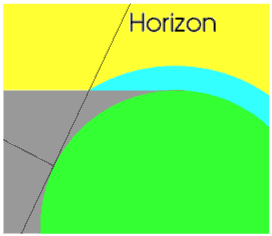
The yellowness is the light of the Sun streaming through space past the Earth, but we cannot see it because there is no atmosphere this high up to scatter it. These drawings greatly exaggerate the thickness of the atmosphere: to the scale the Earth is drawn to on them the atmosphere would be less than 1 mm thick. This means that the amount the Earth has to rotate between Sunset and Nightfall is far less than it appears on these drawings.
Everything is of course reversed when the Sun rises, but because of our lifestyles most of us (except sailors) take more interest in evening twilight than morning twilight.
The period between sunset and nightfall is very special. It is called by many names, twilight, the gloaming and the cool of the evening (or the cool of the day) among them. In the Old Testament of the Bible (Exodus 12) the Children of Israel were commanded to kill the Passover Lamb during this time: different translations of the Bible translate it in different ways, one way is “between the two evenings”.
The time between sunset and nightfall varies according to your latitude and the time of year. In the tropics it is only a few minutes all the year round; in Southern England in the Summer it can be more than an hour, but much less in the Winter. In Scotland in the Summer it is longer still. This is further discussed in the Page on the Seasons.
To some people twilight has a very special meaning. Nautical twilight starts at sunset and ends when it is no longer possible to see the horizon, where the sky meets the sea. (And of course starts again when you can first see the horizon and ends at sunrise.) Civil twilight is the time between sunset and the time you must put on your car headlights. Astronomical twilight is the time between sunset and a totally dark sky.
You can buy an App for your smartphone or tablet which gives you the times of sunrise and sunset and astronomical, civil and nautical twilight for your position for each day of the year, and a lot of other information about the Moon and planets. If you have any interest in astronomy it is well worth downloading.
If you get the opportunity to do this experiment please do do it. In England it is best done on a cloudless evening in August, when sunset is about the right time and astronomical twilight about the right length.
Find a place where you can see most of the sky, well away from street and other outdoor lighting. Starting just after Sunset, search the sky and look for the first “star” in the sky. This might be a true (fixed) star or a planet, and today most people who live in towns cannot tell the difference. It does not matter which it is, so in the rest of this Section I shall use the word star to mean star or planet. You might have to wait several minutes to see your first star. Every time you see a new star count all the stars you can see - then count them again. This is easy until you get to seven. I am not going to tell you what happens next, you must find it out for yourself. But you will find that seven is a special number, hence all the references to the “seven stars in the sky”.